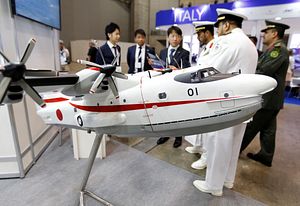The Japanese defense, foreign, and industry ministries are sponsoring a three-day arms exhibit in Chiba, Japan, in an attempt to drum up business for the country’s anemic arms industry. The Maritime Air Systems and Technologies Asia (MAST) exhibition brought together hundreds of defense officials and industry leaders from around the world.
Showcased items include a guided missile destroyer display, a prototype amphibious vehicle model, mine-hunting technology, and demonstrations of a laser radar surveillance system.
As Japanese Prime Minister Shinzo Abe aims to make stronger defense ties with Southeast Asian states a key pillar of Japan’s bolstered security posture, he is aggressively courting the establishment of new industrial-military relationships with these states. As part of that strategy, Japan’s defense ministry invited military representatives from Indonesia, Malaysia, the Philippines, Singapore, Thailand, and Vietnam to a separate military technology seminar, scheduled for immediately after MAST Asia – beginning this Thursday – to increase attendance at the exhibit itself, according to sources.
Hideaki Watanabe, head of the defense ministry’s Acquisition Technology and Logistics Agency (ATLA), spoke on Monday and referenced the changing security situation in East Asia as the primary motivation for Japan’s evolving security role. Trying to assuage the bitter memories that arise when Southeast Asian states recall Japan’s militarist rampage in the 1930s and 1940s, Watanabe pitched Japan’s modern-day proactive pacifism in a positive light. “It is essential to maintain the open and stable sea under the rule of law. Ensuring safety of navigation and flight contributes to the peace and prosperity of Japan and the international society. Japan’s research and development of high-quality defense equipment contribute to the defense of Japan and elsewhere,” he promised.
China’s military build up in the South China Sea was not the only security issue discussed. Panels were also organized on the subject of missile defense; North Korea’s development of missile and nuclear capabilities is distressing to not just Japan and South Korea, but Southeast Asian states as well.
However, Japanese arms sales to Southeast Asian states will remain a pipe dream for a while longer. Japanese companies simply cannot produce equipment cheaply enough to compete with Chinese makers. Operating in a monopsony, Japanese defense companies are used to negotiating directly with the customer – the Japanese government, in this case – and dictating the terms of sale based on intricate government regulations and opaque political considerations. “Competing” is anathema to defense companies – and this entrenched mentality is one of the main reasons Japan lost the Australian submarine bid last year.
But while trepidation remains, Japanese companies appear to have developed a greater willingness to hawk their wares. While in MAST Asia 2015, only NEC Corp exhibited alone and the other firms clustered together in one display, this year, 16 Japanese firms are exhibiting alone – including Mitsubishi Heavy Industries (MHI), Kawasaki Heavy Industries (KHI), and ShinMaywa Industries. They will be demonstrating beside their more advanced, international competitors – Lockheed Martin Corp and Thales SA.
Selling to Southeast Asian states will require not just better public-private cooperation, but also greater inter-ministry cooperation – the Ministry of Foreign Affairs and Ministry of Economy, Trade and Industry have know-how they can offer to the Ministry of Defense if they so choose.
Another, more important reason that arms sales to Southeast Asian states will remain limited for a while longer is that what Southeast Asian states need most is not advanced weapons so much as simple maritime awareness capacity. The benign neglect these waterways enjoyed during the Cold War meant that the Philippines, Vietnam, and other maritime Southeast Asian states never developed even basic intelligence, surveillance, and reconnaissance (ISR) capabilities.
Southeast Asia is a region where Japan and like-minded allies would benefit greatly from strategic coordination. Though the United States, Australia and Japan have different security priorities, there is enough overlap for cooperation. Each country should specialize in addressing their unique concerns (Australia is more concerned about Islamic terrorism and refugees than Japan and the United States are, for example) and bringing their unique capabilities to the table in the most synergistic way possible. For instance, the United States can supply the most advanced weapons, while Japan should focus on Humanitarian Assistance and Disaster Relief (HA/DR) equipment and civilian radar.
While pushing Japanese arms too hard might be counterproductive – pushing away potential clients – even countries like Indonesia, Malaysia, and Thailand are worried about becoming over-reliant on Chinese arms makers. With skilled diplomacy, and sensitivity to Japan’s historical legacy and domestic politics, greater military industrial collaboration between Japan and Southeast Asian states ought to be pushed as a part of Japan’s grand strategy in the era of U.S. retrenchment.

































